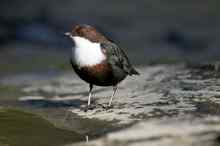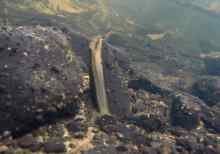Kingfisher Alcedo Atthis is relatively widely distributed throughout the country and throughout the year, not just along waterways, but also around lakes, docks and canals. There were particularly notable clusters along the coastline of Counties Dublin, Meath and Cork, and also in the north midlands. Kingfishers prefer lowland waterways and are territorial, with these territories being vigorously defended in some species.
The Dipper Cinclus Cinclus Hibernicus is one of the most common river birds in Ireland. The dipper is a small to medium sized passerine bird, divided taxonomically into five different species across the world, all of which are unique in their exclusive association with river environments, such as fast flowing streams and rivers.
Dipper feed exclusively on food from the river. They upturn stones, swim underwater and will even walk on the river bed to collect insect larvae which live there.
Otters Lutra Lutra are warm blooded predators usually associated with rivers and other water bodes, including coastal areas. They are widely distributed in Europe although they underwent a significant decline (due to toxic effects of pesticides such as PCBs and habitat loss) in most European countries in the 1950s. There has been a subsequent revival in otter populations in some countries (e.g. UK) due to a number of factors including the recovery of fish stock stocks on which they depend for food.
The freshwater pearl mussel is a bivalve, which is a type of mollusc or snail with a body that is almost completely enclosed between a pair of shells. For most of its life it is a filter feeder, and large quantities of water are pumped through the animal’s siphons and food particles are trapped and passed to the mussel’s mouth. The adult pearl mussel burrows to two-thirds of its shell depth, and is almost sessile in nature, often not moving for 100 years.
IRD Duhallow was delighted to be invited to present at the MulkearLIFE end of project conference last Thursday in the Castle Oaks Hotel, Castleconnel, just outside Limerick. It was a great opportunity to see first hand the fruits of all of the hard work and effort put in by Inland Fisheries Ireland and their partners (NPWS, OPW and Limerick County Council) and coordinated by the MulkearLIFE team. Coordinated by Ruairí Ó Conchúir, project manager of MulkearLIFE, delegates from Ireland, England, Scotland, Wales and Sweden were treated to an action packed line up.
IRD Duhallow and the LIFE project were recently featured on August 23rd on the Saturday Supplement (Frank Lewis) show, Radio Kerry (http://media.radiokerry.ie/mediamanager/embed/player/podcasts/38/item/27369)
This was a fun day out for all the crew, as Frank put us through our paces, profiling the culture, history and ecology of the SPA/SAC at the source of the River Blackwater.
This year and for the first time, IRD Duhallow is running a Biodiversity Camp for children. Project scientist, Kieran Murphy, of LIFE project will lend his expertise and be on hand to guide the children through this exciting event. An event which will see the wildlife of Duhallow come to LIFE. With a particular emphasis on the aquatic environment, children will be brought though the underwater world as well as what lives in the fields, forests and ditches that surround us.
Yes we are asking the public for their help to let no plant go to seed! We are now into our fourth year of this project and we have made dramatic reductions in the extent of Himalayan balsam infestations along the River Allow and Dalua. With the assistance of participants on the Rural Social Scheme, IRD Duhallow staff and volunteers and the local Kanturk Trout Angling Club, the plant has been dramatically reduced in numbers and distribution. In total we have treated over 24km of linear river bank and drain.
Glorious sunshine greeted the end of school term this year for the many students attending national schools in Duhallow. And how fitting the weather was for one of the more fun elements of the LIFE project. Each year during the months of May and June, field excursions are organised to bring the school children closer to nature. For the many students who took part in these field excursions it presents an opportunity to see firsthand, the diversity of aquatic life still present in our rivers.






